Statistical Communiqué of the People's Republic of China on the 2018 National Economic and Social Development
STATISTICAL COMMUNIQUÉ OF
THE PEOPLE'S REPUBLIC OF CHINA
ON THE 2018 NATIONAL
ECONOMIC AND SOCIAL DEVELOPMENT [1]
National Bureau of Statistics of China
February 28, 2019
In 2018, in the face of the complicated and severe international environment as well as the daunting and heavy tasks of reform, development and stability, under the strong leadership of the Central Committee of the Communist Party of China with Comrade Xi Jinping as the core and the guidance of Xi Jinping Thought on Socialism with Chinese Characteristics for a New Era, all regions and departments have implemented the spirit of the 19th National Congress of the Communist Party of China and the second and third plenary sessions of the 19th Central Committee of the Communist Party of China, followed the decisions and arrangements made by the CPC Central Committee and the State Council, promoted balanced economic, political, cultural, social and ecological progress, coordinated the implementation of the four-pronged comprehensive strategy, adhered to the general working guideline of making progress while maintaining stability, thoroughly implemented the new development philosophy and committed to the requirement of high-quality development. All regions and departments have focused on the supply-side structural reform, deepened the reform and opened wider to the world, unswervingly fought the “three critical battles” of forestalling and defusing major risks, conducting targeted poverty alleviation and preventing and controlling pollution, and coped effectively with the profound changes in the external environment. All regions and departments have coordinated the efforts in stabilizing growth, stimulating reform, adjusting structure, benefiting people’s livelihood and fending off risks, and maintained stability in areas like employment, financial sector, foreign trade, foreign investment, domestic investment and market expectation. As a result, the economy was generally stable with growing momentum, the development quality and returns were steadily raised, people’s livelihood was further improved, sustainable and healthy economic development and overall social stability were maintained, and new steps were taken towards the goal of completing the building of a moderately prosperous society in all respects.
I. General Outlook
According to preliminary estimation, the gross domestic product (GDP)[2]in 2018 was 90,030.9 billion yuan, up by 6.6 percent over the previous year. Of this total, the value added of the primary industry was 6,473.4 billion yuan, up by 3.5 percent, that of the secondary industry was 36,600.1 billion yuan, up by 5.8 percent and that of the tertiary industry was 46,957.5 billion yuan, up by 7.6 percent. The value added of the primary industry accounted for 7.2 percent of the GDP; that of the secondary industry accounted for 40.7 percent; and that of the tertiary industry accounted for 52.2 percent. The contribution of the final consumption expenditure to GDP accounted for 76.2 percent, that of the gross capital formation 32.4 percent and that of the net exports of goods and services -8.6 percent. The per capita GDP in 2018 was 64,644 yuan, up by 6.1 percent compared with the previous year. The gross national income[3] in 2018 was 89,691.5 billion yuan, up by 6.5 percent over the previous year. The national energy consumption per 10,000 yuan worth of GDP [4]went down by 3.1 percent over 2017, and the overall labor productivity[5] reached 107,327 yuan per person in 2018, up by 6.6 percent over the previous year.
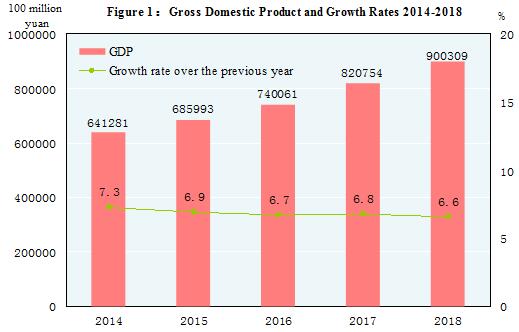
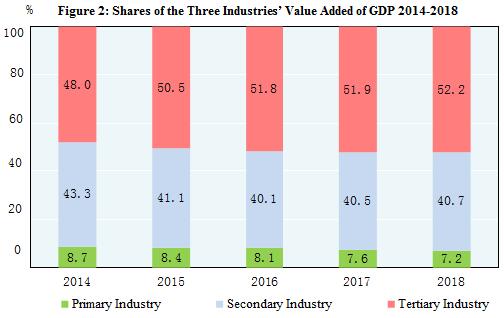
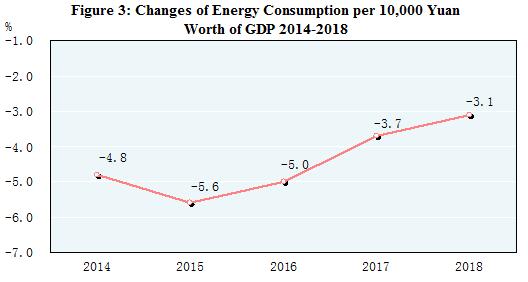

By the end of 2018, the total number of Chinese population at the mainland reached 1,395.38 million, an increase of 5.30 million over that at the end of 2017. Of this total, urban permanent residents numbered 831.37 million, accounting for 59.58 percent of the total population (the urbanization rate of permanent residents), 1.06 percentage points higher than that at the end of 2017. The urbanization rate of population with household registration was 43.37 percent, 1.02 percentage points higher than that at the end of 2017. The year 2018 saw 15.23 million births, a crude birth rate of 10.94 per thousand, and 9.93 million deaths, a crude death rate of 7.13 per thousand. The natural growth rate was 3.81 per thousand. The number of population who live in places other than their household registration areas[6] reached 286 million, of which 241 million were floating population[7].
Table 1: Population and Its Composition by the End of 2018
| Item | Population at Year-end (10,000 persons) | Proportion (%) |
| National Total | 139538 | 100.0 |
| Of which: Urban | 83137 | 59.58 |
| Rural | 56401 | 40.42 |
| Of which: Male | 71351 | 51.1 |
| Female | 68187 | 48.9 |
| Of which: Aged 0-15 (under the age of 16)[8] | 24860 | 17.8 |
| Aged 16-59 (under the age of 60) | 89729 | 64.3 |
| Aged 60 and above | 24949 | 17.9 |
| Of which: Aged 65 and above | 16658 | 11.9 |
At the end of 2018, the number of employed people in China was 775.86 million, and that in urban areas was 434.19 million. The newly increased employed people in urban areas numbered 13.61 million, 0.10 million more than the previous year. The surveyed urban unemployment rate was 4.9 percent at the year end, 0.1 percentage point lower than the end of 2017. The registered urban unemployment rate was 3.8 percent, 0.1 percentage point lower. The total number of migrant workers[9] in 2018 was 288.36 million, up by 0.6 percent over that of 2017. Specifically, the number of migrant workers who left their hometowns and worked in other places was 172.66 million, up by 0.5 percent, and those who worked in their own localities reached 115.70 million, up by 0.9 percent.
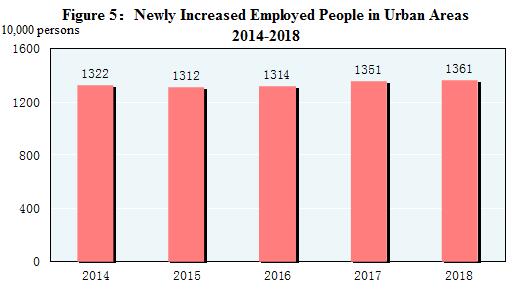
The consumer prices in 2018 went up by 2.1 percent over the previous year. The producer prices went up by 3.5 percent and the purchasing prices for manufactured goods up by 4.1 percent. The prices for investment in fixed assets increased by 5.4 percent. The producer prices for farm products[10] decreased by 0.9 percent. In December, out of the 70 large-and-medium-sized cities, 69 cities experienced a year-on-year rise in sales prices of new commercial residential buildings and one city experienced a decline.

Table 2: Changes of Consumer Prices in 2018
Unit: %
Item | National Average | | |
Urban | Rural | ||
| General level of consumer prices | 2.1 | 2.1 | 2.1 |
| Of which: Food, tobacco and liquor | 1.9 | 2.1 | 1.1 |
| Clothing | 1.2 | 1.1 | 1.5 |
| Residence[11] | 2.4 | 2.1 | 3.3 |
| Household facilities, articles and services | 1.6 | 1.6 | 1.6 |
| Transportation and telecommunication | 1.7 | 1.6 | 1.8 |
| Education, culture and recreation | 2.2 | 2.3 | 2.2 |
| Health care and medical services | 4.3 | 4.6 | 3.7 |
| Miscellaneous goods and services | 1.2 | 1.2 | 1.2 |
At the end of 2018, China’s foreign exchange reserves reached 3,072.7 billion US dollars, 67.2 billion US dollars less compared with that at the end of 2017. The average exchange rate of the year was 6.6174 RMB to 1 USD dollar, appreciated by 2.0 percent over that of 2017.

The supply-side structural reform was further pushed forward. The national industrial capacity utilization rate[12] in 2018 reached 76.5 percent. Specifically, the capacity utilization rate for mining and washing of coal was 70.6 percent, 2.4 percentage points higher than the previous year and that for smelting and pressing of ferrous metals was 78.0 percent, 2.2 percentage points higher. The floor space of commercial buildings for sale at the end of 2018 was 524.14 million square meters, 65.10 million square meters less than that at the end of 2017. Of this total, the floor space of the commercial residential buildings for sale was 250.91 million square meters, 50.72 million square meters less. The asset-liability ratio of the industrial enterprises above the designated size at the end of 2018 was 56.5 percent, 0.5 percentage point[13] less than that at the end of 2017. The cost for per-hundred-yuan turnover of principal activities of the industrial enterprises above the designated size was 83.88 yuan in 2018, 0.20 yuan less compared with the previous year. In 2018, the fixed assets investment (excluding by rural households) in ecological protection and treatment of environmental pollution and in agriculture went up by 43.0 percent and 15.4 percent respectively compared with 2017.
The new driving forces continued to grow. Among the industries above the designated size, the value added of the strategic emerging industries[14] grew by 8.9 percent over the previous year and the value added of the high technology manufacturing industry[15] was up by 11.7 percent over the previous year, accounting for 13.9 percent of that of all industrial enterprises above the designated size. The value added for the manufacture of equipment[16] was up by 8.1 percent, accounting for 32.9 percent of that of all industrial enterprises above the designated size. Among the service enterprises above the designated size[17], the business revenue of the strategic emerging service industries[18] went up by 14.6 percent compared with the previous year.
In 2018, the investment in high technology industries[19] increased by 14.9 percent over the previous year; the investment in industrial technological transformation[20] increased by 12.8 percent. In 2018, the production of new energy vehicles reached 1.15 million, up by 66.2 percent compared with the previous year and that of smart TV sets 113.76 million, up by 17.7 percent. In 2018, the online retail sales[21] reached 9,006.5 billion yuan, an increase of 23.9 percent.
Significant achievement has been made in poverty alleviation. By the rural poverty line of annual per capita income of 2,300 yuan (at 2010 constant prices), the number of rural population living in poverty at the end of 2018 was 16.60 million, 13.86 million[22] less compared with that at the end of 2017, and the incidence of poverty[23] was 1.7 percent, 1.4 percentage points lower than that of the previous year. In 2018, the per capita disposable income of rural residents in impoverished areas[24] was 10,371 yuan, an increase of 10.6 percent over 2017, or a real increase of 8.3 percent after price adjustment.
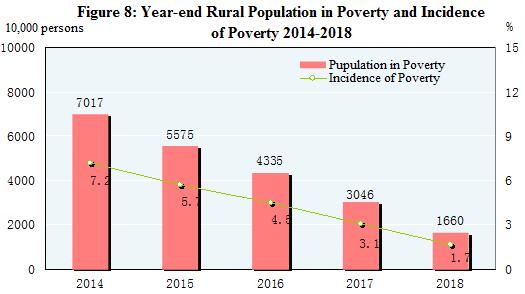
II. Agriculture[25]
In 2018, the sown area of grain was 117.04 million hectares, a drop of 0.95 million hectares compared with that in 2017. Of this total, the sown area of wheat was 24.27 million hectares, a decrease of 0.24 million hectares; the sown area of rice was 30.19 million hectares, a decrease of 0.56 million hectares; the sown area of corn was 42.13 million hectares, a decrease of 0.27 million hectares. The sown area of cotton was 3.35 million hectares, an increase of 0.16 million hectares. The sown area of oil-bearing crops was 12.89 million hectares, a decrease of 0.33 million hectares; the sown area of sugar crops was 1.63 million hectares, an increase of 90 thousand hectares.
The total output of grain in 2018 was 657.89 million tons, a decrease of 3.71 million tons or down by 0.6 percent over the previous year. Of this total, the output of summer crops was 138.78 million tons, down by 2.1 percent, and that of the early rice was 28.59 million tons, down by 4.3 percent over the previous year. The output of autumn grain was 490.52 million tons, up by 0.1 percent.
The output of cereal was 610.19 million tons, down by 0.8 percent over 2017, among which the output of rice was 212.13 million tons, down by 0.3 percent; that of wheat was 131.43 million tons, down by 2.2 percent; and that of corn was 257.33 million tons, down by 0.7 percent.
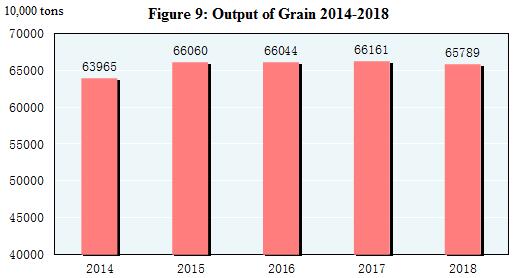
In 2018, the output of cotton was 6.10 million tons, an increase of 7.8 percent over the previous year, that of oil-bearing crops was 34.39 million tons, down by 1.0 percent, that of sugar crops was 119.76 million tons, up by 5.3 percent, and that of tea was 2.61 million tons, up by 5.9 percent.
The total output of pork, beef, mutton and poultry in 2018 reached 85.17 million tons, down by 0.3 percent over the previous year. Of this total, the output of pork was 54.04 million tons, down by 0.9 percent; that of beef was 6.44 million tons, up by 1.5 percent; that of mutton was 4.75 million tons, up by 0.8 percent; and that of poultry was 19.94 million tons, up by 0.6 percent. The total output of eggs was 31.28 million tons, up by 1.0 percent. The production of milk was 30.75 million tons, up by 1.2 percent. At the end of the year, 428.17 million pigs were registered in the total stocks, down by 3.0 percent, and 693.82 million pigs were slaughtered, down by 1.2 percent.
The total output of aquatic products in 2018 was 64.69 million tons, up by 0.4 percent over the previous year. Of this total, the output of cultured aquatic products was 50.18 million tons, up by 2.3 percent; and that of fished aquatic products was 14.51 million tons, down by 5.7 percent over the previous year.
The total production of timber for 2018 reached 84.32 million cubic meters, up by 0.4 percent over the previous year.
In 2018, over 0.72 million hectares of farmland were newly equipped with effective irrigation systems and another 1.44 million hectares of farmland was newly equipped with water-saving irrigation systems.
III. Industry and Construction
In 2018, the total value added of the industrial sector was 30,516.0 billion yuan, up by 6.1 percent over the previous year. The value added of industrial enterprises above the designated size increased by 6.2 percent. Of the industrial enterprises above the designated size, in terms of ownership, the value added of the state-holding enterprises grew by 6.2 percent, that of the share-holding enterprises up by 6.6 percent, that of the enterprises by foreign investors and investors from Hong Kong, Macao and Taiwan up by 4.8 percent and that of private enterprises up by 6.2 percent. In terms of sectors, the value added of the mining industry was up by 2.3 percent, that of manufacturing up by 6.5 percent and that of production and supply of electricity, heat power, gas and water up by 9.9 percent.
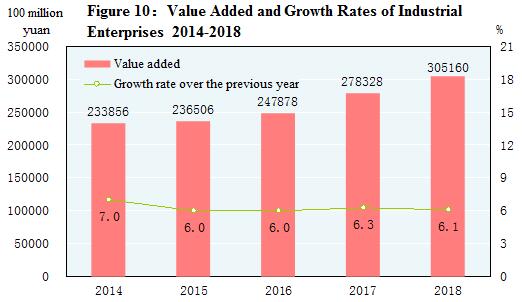
In 2018, of the industrial enterprises above the designated size, the value added for processing of food from agricultural and sideline products was up by 5.9 percent over the previous year; for textile industry up by 1.0 percent; for manufacture of raw chemical materials and chemical products up by 3.6 percent; for manufacture of non-metallic mineral products up by 4.6 percent; for smelting and pressing of ferrous metals up by 7.0 percent; for manufacture of general purpose machinery up by 7.2 percent; for manufacture of special purpose machinery up by 10.9 percent; for manufacture of automobiles up by 4.9 percent; for manufacture of electrical machinery and apparatus up by 7.3 percent; for manufacture of computers, communication equipment and other electronic equipment up by 13.1 percent; for production and supply of electricity and heat power up by 9.6 percent.
Table 3: Output of Major Industrial Products and Growth Rates in 2018[26]
| Product | Unit | Output | Increase over 2017 (%) |
| Yarn | 10000 tons | 2958.9 | -7.3 |
| Cloth | 100 million meters | 657.3 | -4.9 |
| Chemical fiber | 10000 tons | 5011.1 | 2.7 |
| Refined sugar (final product) | 10000 tons | 1524.1 | 3.5 |
| Cigarettes | 100 million | 23358.7 | -0.4 |
| Color TV sets | 10000 | 18834.8 | 18.2 |
| Of which: LCD TV sets | 10000 | 18825.2 | 19.5 |
| Household refrigerators | 10000 | 7993.2 | -3.9 |
| Air conditioners | 10000 | 20486.0 | 14.7 |
| Primary energy output | 100 million tons of standard coal equivalent | 37.7 | 5.0 |
| Coal | 100 million tons | 36.8 | 4.5 |
| Crude petroleum oil | 10000 tons | 18910.6 | -1.3 |
| Natural gas | 100 million cubic meters | 1602.7 | 8.3 |
| Electricity | 100 million kilowatt-hours | 71117.7 | 7.7 |
| Of which: Thermal power[27] | 100 million kilowatt-hours | 50738.6 | 6.7 |
| Hydropower | 100 million kilowatt-hours | 12342.3 | 3.0 |
| Nuclear-power | 100 million kilowatt-hours | 2943.6 | 18.7 |
| Crude steel | 10000 tons | 92800.9 | 6.6 |
| Rolled steel[28] | 10000 tons | 110551.7 | 5.6 |
| Ten kinds of nonferrous metals | 10000 tons | 5702.7 | 3.7 |
| Of which: Refined copper (copper) | 10000 tons | 902.9 | 0.7 |
| Aluminum electrolyze | 10000 tons | 3580.2 | 7.5 |
| Cement | 100 million tons | 22.1 | -5.3 |
| Sulfuric acid (100%) | 10000 tons | 9129.8 | -0.9 |
| Caustic soda (100%) | 10000 tons | 3420.2 | 2.7 |
| Ethylene | 10000 tons | 1841.0 | 1.1 |
| Chemical fertilizers (100 percent equivalent) | 10000 tons | 5424.4 | -7.9 |
| Power generation equipment | 10000 kilowatts | 10600.5 | -10.3 |
| Motor vehicles | 10000 | 2781.9 | -4.1 |
| Of which: Basic passenger cars (cars) | 10000 | 1160.1 | -2.9 |
| Sport utility vehicles (SUVs) | 10000 | 927.4 | -7.7 |
| Large and medium tractors | 10000 | 24.3 | -29.3 |
| Integrated circuits | 100 million pieces | 1739.5 | 11.2 |
| Program-controlled switchboards | 10000 lines | 1006.6 | 7.3 |
| Mobile telephones | 10000 | 179846.4 | -4.8 |
| Micro computer equipment | 10000 | 30700.2 | 0.1 |
| Industrial Robots | 10000 sets | 14.8 | 6.4 |
By the end of 2018, the installed power generation capacity was 1,899.67 million kilowatts, up by 6.5 percent[29] over that at the end of 2017, among which[30] the installed thermal power generation capacity was 1,143.67 million kilowatts, up by 3.0 percent; the installed hydropower generation capacity was 352.26 million kilowatts, up by 2.5 percent; the installed nuclear power generation capacity was 44.66 million kilowatts, up by 24.7 percent. The installed grid-connected wind power generation capacity was 184.26 million kilowatts, up by 12.4 percent and the installed grid-connected solar power generation capacity was 174.63 million kilowatts, up by 33.9 percent.
In 2018, the profits made by industrial enterprises above the designated size were 6,635.1 billion yuan, up by 10.3 percent[31] over the previous year. By ownership, the profits of state-holding enterprises were 1,858.3 billion yuan, up by 12.6 percent over the previous year; those of share-holding enterprises were 4,697.5 billion yuan, up by 14.4 percent; those of enterprises funded by foreign investors or investors from Hong Kong, Macao and Taiwan were 1,677.6 billion yuan, up by 1.9 percent; and those of private enterprises was 1,713.7 billion yuan, up by 11.9 percent. In terms of different sectors, the profits of mining were 524.6 billion yuan, up by 40.1 percent over the previous year; those of manufacturing were 5,696.4 billion yuan, up by 8.7 percent; and those of the production and supply of electricity, heat power, gas and water were 414.1 billion yuan, up by 4.3 percent. In 2018, the profit rate of the principal activities of the industrial enterprises above the designated size was 6.49 percent, 0.11 percentage point higher than that of 2017.
In 2018, the value added of construction enterprises in China was 6,180.8 billion yuan, up by 4.5 percent over the previous year. The profits made by construction enterprises qualified for general contracts and specialized contracts reached 810.4 billion yuan, up by 8.2 percent, of which the profits made by state-holding enterprises were 247.0 billion yuan, up by 8.5 percent.
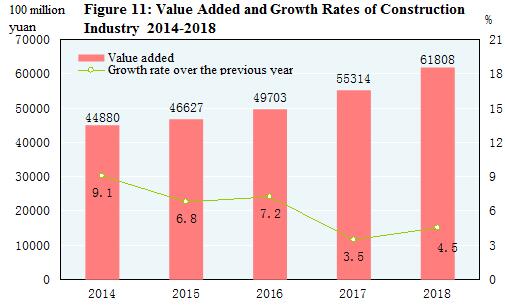
IV. Service Sector
In 2018, the value added of wholesale and retail trades was 8,420.1 billion yuan, up by 6.2 percent over the previous year; that of transport, storage and post was 4,055.0 billion yuan, up by 8.1 percent; that of hotels and catering services was 1,602.3 billion yuan, up by 6.5 percent; that of financial intermediation was 6,910.0 billion yuan, up by 4.4 percent; that of real estate was 5,984.6 billion yuan, up by 3.8 percent; that of information transmission, software and information technology services was 3,243.1 billion yuan, up by 30.7 percent; and that of leasing and business services was 2,442.7 billion yuan, up by 8.9 percent. In 2018, the business revenue of service enterprises above the designated size grew by 11.4 percent over the previous year, and the operating profits grew by 6.5 percent.
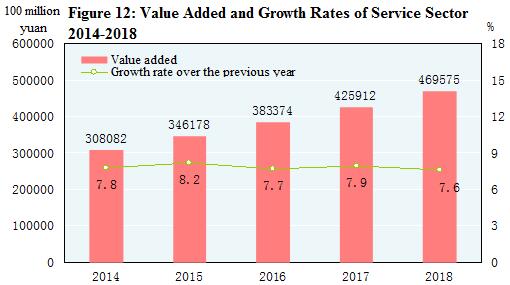
The total freight traffic in 2018 reached 51.5 billion tons, up by 7.1 percent over 2017. The freight flows were 20,545.2 billion ton-kilometers, up by 4.1 percent. The volume of freight handled by ports above the designated size throughout the year totaled 13.3 billion tons, up by 2.7 percent[32] over the previous year, of which the freight for foreign trade was 4.2 billion tons, up by 2.0 percent. Container shipping of ports above the designated size reached 249.55 million standard containers, up by 5.2 percent.
Table 4: Freight Traffic by All Means of Transportation
and Growth Rates in 2018
| Item | Unit | Volume | Increase over 2017(%) |
| Total freight traffic | 100 million tons | 514.6 | 7.1 |
| Railways | 100 million tons | 40.3 | 9.2 |
| Highways | 100 million tons | 395.9 | 7.4 |
| Waterways | 100 million tons | 69.9 | 4.7 |
| Civil aviation | 10 000 tons | 738.5 | 4.6 |
| Pipelines | 100 million tons | 8.5 | 5.4 |
| Freight flows | 100 million ton-kilometers | 205451.6 | 4.1 |
| Railways | 100 million ton-kilometers | 28821.0 | 6.9 |
| Highways | 100 million ton-kilometers | 71202.5 | 6.6 |
| Waterways | 100 million ton-kilometers | 99303.6 | 0.7 |
| Civil aviation | 100 million ton-kilometers | 262.4 | 7.7 |
| Pipelines | 100 million ton-kilometers | 5862.0 | 22.5 |
In 2018, the total passenger traffic[33] reached 17.9 billion person-times, down by 3.1 percent over 2017, and the passenger flows were 3,421.3 billion person-kilometers, up by 4.3 percent.
Table 5: Passenger Traffic by All Means of Transportation
and Growth Rates in 2018
| Item | Unit | Volume | Increase over 2017 (%) |
| Total passenger traffic | 100 million person-times | 179.2 | -3.1 |
| Railways | 100 million person-times | 33.7 | 9.4 |
| Highways | 100 million person-times | 136.5 | -6.3 |
| Waterways | 100 million person-times | 2.8 | -0.5 |
| Civil aviation | 100 million person-times | 6.1 | 10.9 |
| Passenger flows | 100 million person-kilometers | 34213.5 | 4.3 |
| Railways | 100 million person-kilometers | 14146.6 | 5.1 |
| Highways | 100 million person-kilometers | 9275.5 | -5.0 |
| Waterways | 100 million person-kilometers | 79.8 | 2.7 |
| Civil aviation | 100 million person-kilometers | 10711.6 | 12.6 |
The total number of motor vehicles for civilian use reached 240.28 million (including 9.06 million tri-wheel motor vehicles and low-speed trucks) by the end of 2018, up by 10.5 percent over that at the end of 2017, of which the privately-owned vehicles numbered 207.30 million, up by 10.9 percent. The total number of cars for civilian use was 134.51 million, up by 10.4 percent, of which the privately-owned cars numbered 125.89 million, up by 10.3 percent.
The turnover of post services[34] totaled 1,234.5 billion yuan, up by 26.4 percent over the previous year. The number of mail delivery was 2.68 billion; that of parcel delivery was 20 million; and that of express delivery was 50.71 billion with a revenue reaching 603.8 billion yuan. The turnover of telecommunication services[35] totaled 6,555.6 billion yuan, up by 137.9 percent over the previous year. The newly increased capacity of mobile phone switchboard[36] was 172.67 million lines with the total capacity reaching 2,594.53 million lines. By the end of 2018, there were 1,748.35 million phone subscribers in China, of whom 1,566.10 million were mobile phone users. Mobile phone coverage rose to 112.2 sets per 100 persons. The number of fixed broadband internet users[37] reached 407.38 million, increased by 58.84 million over the previous year. Of this total, fixed fiber-optic broadband internet users[38] amounted to 368.33 million, an increase of 74.40 million; and the mobile broadband users[39] numbered 1,305.65 million, an increase of 174.13 million. The mobile internet traffic in 2018 was 71.1 billion gigabytes, up by 189.1 percent over the previous year. Software revenue from software and information technology services industry[40] in 2018 was 6,306.1 billion yuan, up by 14.2 percent over 2017 on a comparable basis.


V. Domestic Trade[41]
In 2018, the total retail sales of consumer goods reached 38,098.7 billion yuan, a growth of 9.0 percent over the previous year. An analysis on different areas showed that the retail sales of consumer goods in urban areas stood at 32,563.7 billion yuan, up by 8.8 percent, and that in rural areas reached 5,535.0 billion yuan, up by 10.1 percent. Grouped by consumption patterns, the retail sales of commodities was 33,827.1 billion yuan, up by 8.9 percent, and that of catering industry was 4,271.6 billion yuan, up by 9.5 percent.
Of the total retail sales of commodities by enterprises above the designated size, the year-on-year growth of sales for grain, oil and food went up by 10.2 percent; beverage up by 9.0 percent; tobacco and liquor up by 7.4 percent; clothes, shoes, hats and textiles up by 8.0 percent; cosmetics up by 9.6 percent; gold, silver and jewelry up by 7.4 percent; daily necessities up by 13.7 percent; household appliances and audio-video equipments up by 8.9 percent; traditional Chinese and western medicines up by 9.4 percent; cultural and office appliances up by 3.0 percent; furniture up by 10.1 percent; telecommunication equipments up by 7.1 percent; building and decoration materials up by 8.1 percent; petroleum and petroleum products up by 13.3 percent; and motor vehicles down by 2.4 percent.
In 2018, the online retail sales of physical goods were 7,019.8 billion yuan, up by 25.4 percent over the previous year, accounting for 18.4 percent of the total retail sales of consumer goods, or 3.4 percentage points higher than that of 2017.
VI. Investment in Fixed Assets[42]
The total investment in fixed assets of the country in 2018 was 64,567.5 billion yuan, up by 5.9 percent over the previous year. Of the total investment, the investment in fixed assets (excluding by rural households) was 63,563.6 billion yuan, up by 5.9 percent. By regions[43], the investment in eastern areas was up by 5.7 percent over the previous year, central areas up by 10.0 percent, western areas up by 4.7 percent, and northeastern areas up by 1.0 percent.
In the investment in fixed assets (excluding by rural households), the investment in the primary industry was 2,241.3 billion yuan, up by 12.9 percent; that in the secondary industry was 23,789.9 billion yuan, up by 6.2 percent; and that in the tertiary industry was 37,532.4 billion yuan, up by 5.5 percent. The private investment in fixed assets[44] was 39,405.1 billion yuan, up by 8.7 percent, accounting for 62.0 percent of the investment in fixed assets (excluding by rural households). The investment in infrastructure[45] saw an increase of 3.8 percent. The investment in the six major high energy consuming industries grew by 1.4 percent.
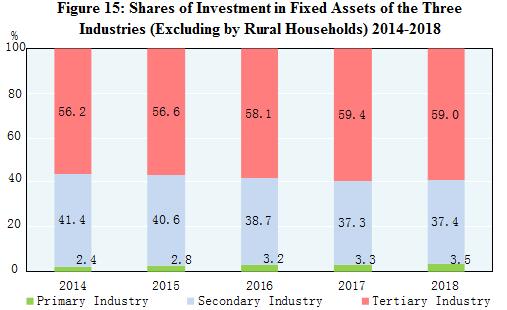
Table 6: Growth Rates of Investment in Fixed Assets (Excluding by Rural
Households) by Sectors in 2018
| Sector | Increase over 2017 (%) | Sector | Increase over 2017 (%) |
| Total | 5.9 | Financial Intermediation | -13.1 |
| Agriculture, Forestry, Animal Husbandry and Fishery | 12.3 | Real Estate[46] | 8.3 |
| Mining | 4.1 | Leasing and Business Services | 14.2 |
| Manufacturing | 9.5 | Scientific Research and Technical Services | 13.6 |
| Production and Supply of Electricity, Heat, Gas and Water | -6.7 | Water Conservancy, Environment and Public Facilities Management | 3.3 |
| Construction | -13.9 | Services to Households, Repair and Other Services | -14.4 |
| Wholesale and Retail Trades | -21.5 | Education | 7.2 |
| Transport, Storage and Post | 3.9 | Health and Social Service | 8.4 |
| Hotels and Catering Services | -3.4 | Culture, Sports and Entertainment | 21.2 |
| Information Transmission, Software and Information Technology Services | 4.0 | Public Management, Social Security and Social Organizations | -18.0 |
Table 7: Newly Increased Production and Operation Capacity through
Fixed Assets Investment in 2018
| Item | Unit | Volume |
| Newly increased power transformer equipment with a capacity of over 220 kilovolts | 10000 kilovolt-amperes | 22082 |
| New railways put into operation | kilometer | 4683 |
| Of which, high-speed railways[47] | kilometer | 4100 |
| Extended or new double-track railways put into operation | kilometer | 4711 |
| Electrified railways put into operation | kilometer | 6474 |
| Length of New and rebuilt highways | kilometer | 356045 |
| Of which: Expressways | kilometer | 6063 |
| New throughput capacity of berths for over 10,000-tonnage ships | 10000 tons/year | 26428 |
| New civil transportation airports | - | 6 |
| New lines of optical-fiber cables | 10000 km | 578 |
In 2018, the investment in real estate development was 12,026.4 billion yuan, up by 9.5 percent. Of this total, the investment in residential buildings reached 8,519.2 billion yuan, an increase of 13.4 percent, that in office buildings was 599.6 billion yuan, down by 11.3 percent, and that in buildings for commercial business was 1,417.7 billion yuan, down by 9.4 percent.
In 2018, some 6.26 million housing units were started to be rebuilt in rundown urban areas nationwide. The number of housing units rebuilt in rundown areas was 5.11 million. In rural areas of China, among the poverty-stricken households that had their economic status registered at the local governments, and 1.57 million[48] of them had witnessed their dilapidate houses rebuilt and renovated in 2018.
Table 8: Main Indicators for Real Estate Development and Sales
and Their Growth Rates in 2018
| Item | Unit | Volume | Increase over 2017 (%) |
| Value of Investment | 100 million RMB | 120264 | 9.5 |
| Of which: residential buildings | 100 million RMB | 85192 | 13.4 |
| Floor space of buildings under construction | 10,000 square meters | 822300 | 5.2 |
| Of which: residential buildings | 10,000 square meters | 569987 | 6.3 |
| Floor space of buildings newly started | 10,000 square meters | 209342 | 17.2 |
| Of which: residential buildings | 10,000 square meters | 153353 | 19.7 |
| Floor space of buildings completed | 10,000 square meters | 93550 | -7.8 |
| Of which: residential buildings | 10,000 square meters | 66016 | -8.1 |
| Sales of commercialized buildings | 10,000 square meters | 171654 | 1.3 |
| Of which: residential buildings | 10,000 square meters | 147929 | 2.2 |
| Funds for investment this year | 100 million RMB | 165963 | 6.4 |
| Of which: domestic loans | 100 million RMB | 24005 | -4.9 |
| individual mortgage | 100 million RMB | 23706 | -0.8 |
VII. Foreign Economic Relations
The total value of imports and exports of goods in 2018 reached 30,505.0 billion yuan, up by 9.7 percent over the previous year. Of this total, the value of goods exported was 16,417.7 billion yuan, up by 7.1 percent; the value of goods imported was 14,087.4 billion yuan, up by 12.9 percent. The surplus of trade in goods reached 2,330.3 billion yuan, down by 521.7 billion yuan over the previous year. The total value of goods imported from and exported to countries along the Belt and Road[49] was 8,365.7 billion yuan, an increase of 13.3 percent over the previous year. Of the total, the value of goods exported was 4,647.8 billion yuan, an increase of 7.9 percent; that of goods imported was 3,717.9 billion yuan, an increase of 20.9 percent.

Table 9: Total Value of Import and Export of Goods
and the Growth Rates in 2018
| Item | Value (100 million yuan) | Increase over 2017 (%) |
| Total value of import and export of goods | 305050 | 9.7 |
| Exports | 164177 | 7.1 |
| Of which: General trade | 92405 | 10.9 |
| Processing trade | 52676 | 2.5 |
| Of which: Mechanical and electronic products | 96457 | 7.9 |
| High & new technology products | 49374 | 9.3 |
| Imports | 140874 | 12.9 |
| Of which: General trade | 83947 | 14.3 |
| Processing trade | 31097 | 6.6 |
| Of which: Mechanical and electronic products | 63727 | 10.3 |
| High & new technology products | 44340 | 12.2 |
| Trade surplus | 23303 | - |
Table 10: Main Export Commodities in Volume and Value
and the Growth Rates in 2018
| Item | Unit | Volume | Increase over 2017 (%) | Value (100 million yuan) | Increase over 2017 (%) |
| Rolled steel | 10000 tons | 6934 | -8.1 | 3984 | 7.7 |
| Textile yarns and textile articles | ---- | — | — | 7851 | 5.1 |
| Clothes and clothing accessories | ---- | — | — | 10413 | -2.3 |
| Footwear | 10000 tons | 448 | -0.4 | 3095 | -5.4 |
| Furniture and parts | ---- | — | — | 3544 | 4.8 |
| Luggage and similar containers | 10000 tons | 316 | 2.0 | 1787 | -1.0 |
| Toys | — | — | — | 1662 | 2.3 |
| Plastic articles | 10000 tons | 1312 | 12.3 | 2870 | 9.3 |
| Integrated circuits | 100 million pieces | 2171 | 6.2 | 5591 | 23.5 |
| Automatic data processing machines and components | 10000 sets | 147296 | -4.4 | 11355 | 6.0 |
| Handheld mobiles and car telephones | 10000 sets | 111918 | -7.8 | 9343 | 9.8 |
| Containers | 10000 units | 340 | 13.5 | 685 | 20.9 |
| Liquid crystal display panels | 10000 units | 175810 | -9.3 | 1527 | -12.5 |
| Motor vehicles | 10000 sets | 115 | 11.3 | 972 | 8.3 |
Table 11: Main Import Commodities in Volume and Value
and the Growth Rates in 2018
| Item | Unit | Volume | Increase over 2017 (%) | Value (100 million yuan) | Increase over 2017 (%) |
| Cereals and cereals flour | 10000 tons | 2047 | -20.0 | 385 | -12.4 |
| Soybean | 10000 tons | 8803 | -7.9 | 2502 | -6.9 |
| Edible vegetable oil | 10000 tons | 629 | 9.0 | 313 | 2.0 |
| Iron ore and concentrate | 10000 tons | 106447 | -1.0 | 4984 | -4.0 |
| Coal and lignite | 10000 tons | 28123 | 3.9 | 1613 | 4.9 |
| Crude oil | 10000 tons | 46190 | 10.1 | 15882 | 43.1 |
| Petroleum products refined | 10000 tons | 3348 | 13.0 | 1333 | 35.6 |
| Natural gas | 10000 tons | 9039 | 31.9 | 2552 | 62.1 |
| Plastics in primary forms | 10000 tons | 3284 | 14.5 | 3718 | 13.2 |
| Paper pulp | 10000 tons | 2479 | 4.5 | 1300 | 25.1 |
| Rolled steel | 10000 tons | 1317 | -1.0 | 1083 | 5.5 |
| Unwrought copper and its alloys | 10000 tons | 530 | 12.9 | 2469 | 16.5 |
| Integrated circuits | 100 million pieces | 4176 | 10.8 | 20584 | 16.9 |
| Motor vehicles | 10000 sets | 113 | -8.5 | 3331 | -2.7 |
Table 12: Imports and Exports of Goods by Major Countries and Regions,
the Growth Rates and Proportions in 2018
| Country or region | Exports (100 million yuan) | Increase over 2017 (%) | Proportion of the total (%) | Imports (100 million yuan) | Increase over 2017 (%) | Proportion of the total (%) |
| European Union | 26974 | 7.0 | 16.4 | 18067 | 9.2 | 12.8 |
| United States | 31603 | 8.6 | 19.2 | 10195 | -2.3 | 7.2 |
| ASEAN | 21066 | 11.3 | 12.8 | 17722 | 11.0 | 12.6 |
| Japan | 9709 | 4.4 | 5.9 | 11906 | 6.2 | 8.5 |
| Republic of Korea | 7174 | 3.1 | 4.4 | 13495 | 12.3 | 9.6 |
| Hong Kong, China | 19966 | 5.7 | 12.2 | 564 | 13.8 | 0.4 |
| Taiwan, China | 3212 | 7.9 | 2.0 | 11714 | 11.0 | 8.3 |
| Brazil | 2214 | 12.9 | 1.3 | 5119 | 28.2 | 3.6 |
| Russia | 3167 | 9.1 | 1.9 | 3909 | 39.4 | 2.8 |
| India | 5054 | 9.5 | 3.1 | 1242 | 12.2 | 0.9 |
| South Africa | 1072 | 6.9 | 0.7 | 1799 | 8.9 | 1.3 |
The total value of imports and exports of services[50] in 2018 was 5,240.2 billion yuan, up by 11.5 percent. The export value of services was 1,765.8 billion yuan, up by 14.6 percent. The import value of services was 3,474.4 billion yuan, up by 10.0 percent. The trade deficit in imports and exports of services was 1,708.6 billion yuan.
The year 2018 witnessed the establishment of 60,533 enterprises (excluding banking, securities and insurance) with foreign direct investment, up by 69.8 percent over the previous year, and the foreign direct investment actually utilized was 885.6 billion yuan , up by 0.9 percent, or 135.0 billion US dollars, up by 3.0 percent. Specifically, there were 4,479 newly established enterprises receiving direct investment from countries along the Belt and Road, up by 16.1 percent; and the foreign capital directly invested in China was 42.4 billion yuan, up by 13.2 percent, or 6.4 billion US dollars, up by 16.0 percent. In 2018, the foreign investment actually utilized by high technology manufacturing industry reached 89.8 billion yuan, up by 35.1 percent, or 13.7 billion US dollars, up by 38.1 percent.
Table 13: Total Value of Foreign Direct Investment (Excluding Banking,
Securities and Insurance) and the Growth Rates in 2018
| Sector | Enterprises | Increase over 2017 (%) | Actually Utilized Value (100 million yuan) | Increase over 2017 (%) |
| Total | 60533 | 69.8 | 8856 | 0.9 |
| Of which: Agriculture, Forestry, Animal Husbandry and Fishery | 741 | 5.0 | 53 | -26.4 |
| Manufacturing | 6152 | 23.4 | 2713 | 20.1 |
| Production and Supply of Electricity, Heat, Gas and Water | 284 | -23.7 | 291 | 23.6 |
| Transport, Storage and Post | 754 | 45.8 | 314 | -16.0 |
| Information Transmission, Software and Information Technology | 7222 | 127.9 | 773 | -44.4 |
| Wholesale and Retail Trades | 22853 | 86.1 | 643 | -16.5 |
| Real Estate | 1053 | 42.9 | 1489 | 31.4 |
| Leasing and Business Services | 9099 | 78.9 | 1196 | 6.4 |
| Services to Households, Repair and Other Services | 485 | 39.0 | 37 | -2.6 |
In 2018, the non-financial outbound direct investment reached 797.4 billion yuan, down by 1.6 percent, or 120.5 billion US dollars, up by 0.3 percent, of this total, that to countries along the Belt and Road reached 15.6 billion US dollars, up by 8.9 percent.
Table 14: Total Value of Non-financial Outbound Direct Investment
and the Growth Rates in 2018
| Sector | Value (100 million US dollars) | Increase over 2017 (%) | |
| Total | 1205 | 0.3 | |
| Of which: | Agriculture, Forestry, Animal Husbandry and Fishery | 18 | -20.3 |
| Mining | 92 | 11.3 | |
| Manufacturing | 188 | -1.6 | |
| Production and Supply of Electricity, Heat , Gas and Water | 32 | -0.9 | |
| Construction | 74 | 0.8 | |
| Wholesale and Retail Trades | 106 | -57.5 | |
| Transport, Storage and Post | 58 | 92.7 | |
| Information Transmission, Software and Information Technology | 68 | -33.7 | |
| Real Estate | 40 | 82.0 | |
| | Leasing and Business Services | 446 | 27.6 |
In 2018, the accomplished business revenue through contracted overseas engineering projects was 1,118.6 billion yuan, down by 1.7 percent, or 169.0 billion US dollars, up by 0.3 percent. Specifically, the accomplished business revenue from countries along the Belt and Road was 89.3 billion US dollars, an increase of 4.4 percent, accounting for 52.8 percent of the accomplished business revenue through contracted overseas engineering projects. The number of labor forces sent abroad through overseas labor contracts was 490 thousand.
VIII. Finance and Financial Intermediation
The general public budget revenue reached 18,335.2 billion yuan in 2018, up by 6.2 percent, of which tax revenue amounted to 15,640.1 billion yuan, an increase of 1,203.1 billion yuan, up by 8.3 percent. The value of local government bonds issued to replace outstanding debt in 2018 reached 1,313.0 billion yuan, with an average interest rate of 3.89 percent. From 2015 to 2018, the bonds issued to replace outstanding debts totaled 12.2 trillion yuan, fulfilling the replacement goal set for existing government debt. Through replacement, the average interest rate of local government debt at the end of 2018 was 6.5 percentage points lower than that at the end of 2014, saving approximately 1.7 trillion yuan in interest payment.
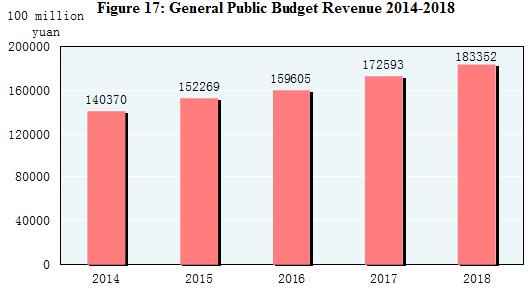
Note: Data for general public budget revenue from 2014 to 2017 as shown in the figure were final accounts and that of 2018 was the executive accounts.
By the end of 2018, money supply of broad sense (M2) was 182.7 trillion yuan, an increase of 8.1 percent over that by the end of the previous year. Money supply of narrow sense (M1) was 55.2 trillion yuan, up by 1.5 percent. Cash in circulation (M0) was 7.3 trillion yuan, up by 3.6 percent.
In 2018, the increment of social financing[51] reached 19.3 trillion yuan, or 3.1 trillion yuan less than that in 2017 on a comparable basis. The balance of social financing[52] totaled 200.7 trillion yuan at the end of 2018, up by 9.8 percent compared with that at the end of 2017. Savings deposit in Renminbi and foreign currencies in all items of financial institutions totaled 182.5 trillion yuan at the end of 2018, an increase of 13.2 trillion yuan compared with that at the beginning of the year. Of this total, the savings deposit in Renminbi stood at 177.5 trillion yuan, an increase of 13.4 trillion yuan. Loans in Renminbi and foreign currencies in all items of financial institutions reached 141.8 trillion yuan, an increase of 16.2 trillion yuan. Of this total, loans in Renminbi were 136.3 trillion yuan, an increase of 16.2 trillion yuan.
Table 15: Savings Deposit and Loans in RMB and Foreign Currencies in
All Financial Institutions and the Growth Rates at the End of 2018
| Item | Year-end figure (100 million yuan) | Increase over 2017 (%) |
| Savings deposit | 1825158 | 7.8 |
| Domestic households | 724439 | 11.1 |
| Deposits in RMB | 716038 | 11.2 |
| Domestic non-financial enterprises | 589105 | 3.1 |
| Loans | 1417516 | 12.9 |
| Domestic short-term loans | 443200 | 7.8 |
| Domestic medium and long-term loans | 854571 | 13.8 |
Loans in Renminbi from rural financial institutions (rural credit cooperatives, rural cooperation banks and rural commercial banks) totaled 16,982.2 billion yuan by the end of 2018, an increase of 2,000.2 billion yuan as compared with the beginning of the year. The loans in Renminbi for consumption use from all financial institutions totaled 37,790.3 billion yuan, an increase of 6,270.9 billion yuan. Of the total, short-term personal loans totaled 8,799.4 billion yuan, an increase of 1,998.9 billion yuan, and medium and long-term personal loans reached 28,990.9 billion yuan, an increase of 4,272.0 billion yuan.
Funds raised through domestic exchange markets[53] amounted to 6,436.5 billion yuan in 2018, an increase of 1,357.2 billion yuan from the previous year. Of this total, 105 A-shares were newly issued, raising 137.8 billion yuan worth of capital altogether, down by 92.3 billion yuan. The refinancing of A-shares (including public newly issued, targeted placement, right issued, and preferred stock) raised 550.5 billion yuan, a decrease of 250.4 billion yuan. Various types of market entities financed 5,687.8 billion yuan through issuing bonds (including corporate bonds, convertible bonds, exchangeable bonds, financial bonds issued by policy banks, local government bonds and asset-backed securities) on Shanghai and Shenzhen Stock Exchanges, up by 1,773.1 billion yuan. In 2018, 577 companies were newly listed on National Equities Exchange and Quotations[51] and funds raised by listed companies reached 60.4 billion yuan.
In 2018, 7.79 trillion yuan corporate debenture bonds[55] were issued, an increase of 1.92 trillion yuan over the previous year.
The premium of primary insurance received by the insurance companies[56] totaled 3,801.7 billion yuan in 2018, up by 3.9 percent over that of the previous year. Of this total, life insurance premium of primary insurance amounted to 2,072.3 billion yuan, health and casualty insurance premium of primary insurance 652.4 billion yuan, and property insurance premium of primary insurance 1,077.0 billion yuan. Insurance companies paid an indemnity worth of 1,229.8 billion yuan, of which, life insurance indemnity was 438.9 billion yuan, health and casualty insurance indemnity 201.2 billion yuan, and property insurance indemnity 589.7 billion yuan.
IX. Households Income and Consumption and Social Security
In 2018, the per capita disposable income nationwide was 28,228 yuan, an increase of 8.7 percent or a real increase of 6.5 percent after deducting price factors. The median[57] of per capita disposable income nationwide was 24,336 yuan, up by 8.6 percent. In terms of usual residence, the per capita disposable income of urban households was 39,251 yuan, up by 7.8 percent over that of 2017, or a real growth of 5.6 percent after deducting price factors. The median of per capita disposable income of urban households was 36,413 yuan, up by 7.6 percent. The per capita disposable income of rural households was 14,617 yuan, up by 8.8 percent, or 6.6 percent in real terms. The median of per capita disposable income of rural households was 13,066 yuan, up by 9.2 percent. Grouped by income quintile[58], the per capita disposable income of low-income group reached 6,440 yuan, the lower-middle-income group 14,361 yuan, the middle-income group 23,189 yuan, the upper-middle-income group 36,471 yuan and the high-income group 70,640 yuan. The per capita monthly income of migrant workers was 3,721 yuan, increased by 6.8 percent over the previous year.
The national per capita consumption expenditure was 19,853 yuan, up by 8.4 percent, or a real growth of 6.2 percent after deducting price factors. In terms of usual residence, the per capita consumption expenditure of urban households was 26,112 yuan, up by 6.8 percent, or 4.6 percent in real terms after deducting price factors. The per capita consumption expenditure of rural households was 12,124 yuan, up by 10.7 percent, or a real growth of 8.4 percent after deducting price factors. The national Engel’s Coefficient stood at 28.4 percent, 0.9 percentage point lower than that of the previous year, with that of urban and rural households standing at 27.7 percent and 30.1 percent respectively.
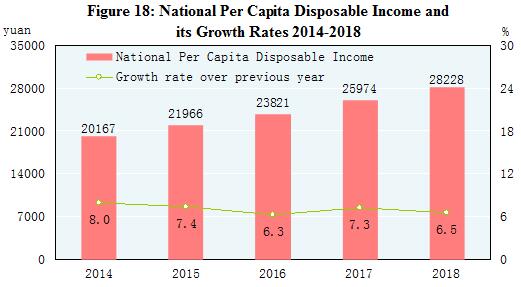
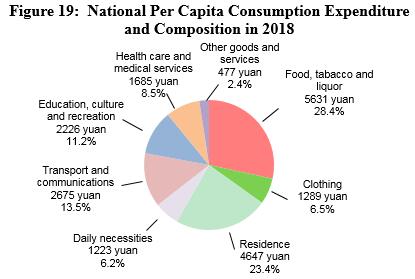
By the end of 2018, a total of 418.48 million people participated in urban basic pension program for staff and workers, a year-on-year increase of 15.55 million. A total of 523.92 million people participated in basic pension insurance program for urban and rural residents, an increase of 11.37 million. A total of 1,344.52 million people participated in basic medical insurance program, an increase of 167.71 million. Of this total, 316.73 million people participated in the program for staff and workers, an increase of 13.51 million, and 897.41 million people participated in the program for urban and rural residents, an increase of 23.82 million. Some 196.43 million people participated in unemployment insurance program, an increase of 8.59 million. The number of people receiving unemployment insurance payment stood at 2.23 million by the end of 2018. A total of 238.68 million people participated in work accident insurance, an increase of 11.45 million, of which 80.85 million were migrant workers, an increase of 2.78 million. A total of 204.35 million people participated in maternity insurance programs, an increase of 11.35 million. Minimum living allowances were granted to 10.08 million urban residents and 35.20 million rural residents, and 4.55 million rural residents living in extreme poverty[59] received relief and assistance and 10.75 million person-times received temporary assistance[60]. A total of 49.72 million people were financed to participate in basic medical insurance program and medical assistance was granted to 38.25 million person-times. National subsidies and allowances were provided to 8.61 million veterans and other entitled people.
By the end of 2018, there were altogether 33 thousand social welfare institutions providing accommodation, of which 30 thousand were elder-caring organizations and 664 were children caring organizations. The social welfare institutions provided 7.824 million beds[61], of which 7.463 million were for the elderly and 104 thousand were for children. By the end of 2018, there were 27 thousand community service centers and 145 thousand community service stations.
X. Science & Technology and Education
Expenditures on research and experimental development activities (R&D) were worth 1,965.7 billion yuan in 2018, up by 11.6 percent over 2017, accounting for 2.18 percent of GDP. Of this total, 111.8 billion yuan was appropriated for basic research programs. A total number of 1,052 projects were arranged under the national key research and development program. Another 563 subject researches were arranged under the national science and technology major projects and 44,504 projects were financed by the National Natural Science Foundation. By the end of 2018, there were altogether 501 state key laboratories in operation, 132 national engineering research centers, 217 national engineering laboratories, and 1,480 national enterprise technical centers. The National Fund for Technology Transfer and Commercialization established 21 sub-funds, with the total size reaching 31.3 billion yuan. There were 4,323 thousand patent applications from home and abroad, up by 16.9 percent, and a total of 2,447 thousand were authorized, up by 33.3 percent. The number of PCT patent applications accepted[62] was 55 thousand. By the end of 2018, the number of patents in force was 8.381 million, of which 1,602 thousand were invention patents from home. The number of invention patents per 10,000 people was 11.5. A total of 412 thousand technology transfer contracts were signed, representing 1,769.7 billion yuan in value, up by 31.8 percent over the previous year.
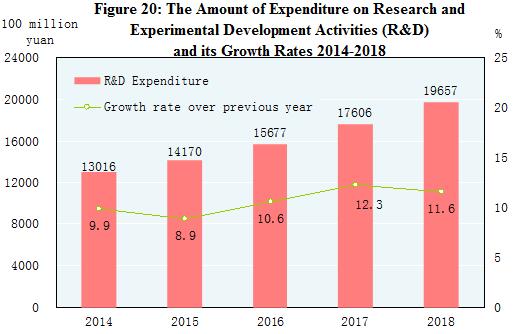
Table 16: Number of Patent Applications, Patents Authorized
and Patents in Force in 2018
| Item | Patents (10,000) | Increase over 2017 (%) |
| Number of patent applications | 432.3 | 16.9 |
| Of which: domestic | 412.1 | 17.3 |
| Of which: for new inventions | 154.2 | 11.6 |
| Of which: domestic | 138.1 | 11.9 |
| Number of patents authorized | 244.7 | 33.3 |
| Of which: domestic | 231.9 | 36.0 |
| Of which: for new inventions | 43.2 | 2.9 |
| Of which: domestic | 34.0 | 6.0 |
| Number of patents in force at the end of the year | 838.1 | 17.3 |
| Of which: domestic | 739.9 | 19.3 |
| Of which: for new inventions | 236.6 | 13.5 |
| Of which: domestic | 160.2 | 18.1 |
The year 2018 saw 38 times of successful satellite launches. Chang´e-4 probe made a successful landing on the far side of the moon and transmitted data back to the earth via the relay satellite, marking the beginning of exploration on the far side of the moon for the first time in human history. The basic system for Beidou-3 was completed, providing global services. The China-Italy Electromagnetic Monitoring Experiment Satellite by the first space-based platform for China´s stereo seismic monitoring system and the first China-France Oceanography satellite under Sino-French space cooperation were launched successfully. The second aircraft carrier started its sea trial, the domestically-made amphibious aircraft completed maiden water takeoff and the Hongkong-Zhuhai-Macao Bridge officially opened to the traffic.
By the end of 2018, there were altogether 791 national quality inspection centers. There were 484 agencies for product quality and management system and service certification, accumulatively 630,000 enterprises were certified. There were 5,030 authorized measurement institutions in the year, enforcing compulsory inspection on 104.06 million measurement instruments. A total of 2,668 national standards were developed or revised in the year, including 1,935 new standards. The qualification rate of manufactured products[63] reached 93.93 percent.
In 2018, the post-graduate education enrollment was 2.731 million students with 858 thousand new students and 604 thousand graduates. The general tertiary education enrollment was 28.310 million students with 7.910 million new students and 7.533 million graduates. Vocational secondary schools[64] had 15.552 million enrolled students, including 5.570 million new entrants, and 4.873 million graduates. Senior secondary schools had 23.754 million enrolled students, including 7.927 million new entrants, and 7.792 million graduates. Students enrolled in junior secondary schools totaled 46.526 million, including 16.026 million new entrants, and 13.678 million graduates. The country had a primary education enrollment of 103.393 million students, including 18.673 million new entrants, and 16.165 million graduates. There were 666 thousand students enrolled in special education schools, with 124 thousand new entrants and 81 thousand graduates. Kindergartens accommodated 46.564 million children. The number of students graduating from compulsory education reached 94.2 percent of the total enrollment, the gross enrollment rate in senior high schools reached 88.8 percent.
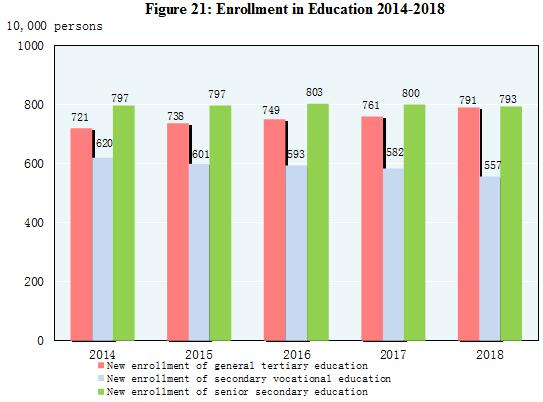
XI. Culture and Tourism, Public Health and Sports
At the end of 2018, there were 2,075 art-performing groups and 3,331 museums in the cultural system throughout China. A total of 3,173 public libraries received[65] 845.29 million people. There were 3,326 cultural centers. Subscribers to cable television programs numbered 214 million, in which 202 million subscribed to digital cable television programs. Radio broadcasting and television broadcasting coverage rates were 98.9 percent and 99.3 percent respectively. A total of 13,726 episodes of 323 TV series and 86,257 minutes of TV cartoons were made in 2018. The country produced 902 feature movies and 180 science, educational, documentary, cartoon and special movies[66]. A total of 34.0 billion copies of newspapers and 2.4 billion copies of magazines were issued, and 9.5 billion copies of books were published. The average number of books possessed per person[67] was 6.85 copies. By the end of the year, there were 4,210 archives in China and 140.16 million files were made accessible to the public.
The year 2018 registered 5.54 billion domestic tourists, up by 10.8 percent over the previous year. The revenue from domestic tourism totaled 5,127.8 billion yuan, up by 12.3 percent. The number of inbound visitors to China totaled 141.20 million, an increase of 1.2 percent. Of this total, 30.54 million were foreigners, up by 4.7 percent; and 110.66 million were Chinese compatriots from Hong Kong, Macao and Taiwan, up by 0.3 percent. Of all the inbound tourists, overnight visitors counted 62.90 million, an increase of 3.6 percent. Earnings from international tourism topped 127.1 billion US dollars, up by 3.0 percent. The number of China’s outbound visitors totaled 161.99 million, up by 13.5 percent. Of this total, 155.02 million were on private visits, an increase of 14.1 percent; and 99.19 million visited Hong Kong, Macao and Taiwan, up by 14.0 percent.

By the end of 2018, there were 1,004,000 medical and health institutions in China, including 32,000 hospitals. Of all the hospitals, 12,000 were public, and 20,000 were private. Of the 950,000 medical and health institutions at grass-root level, there were 36,000 township health centers, 35,000 community health service centers, 248,000 clinics and 630,000 village clinics. Of the 19,000 professional public health institutions, 3,469 were disease control and prevention centers and 3,141 were health monitoring institutions. By the end of 2018, there were 9.50 million medical technical personnel in China, including 3.58 million licensed doctors and licensed assistant doctors and 4.12 million registered nurses. The medical and health institutions in China possessed 8.45 million beds, of which, hospitals possessed 6.56 million and township health centers had 1.34 million. The total number of medical visits[68]and hospital discharges[69]in 2018 reached 8.42 billion and 260 million respectively.
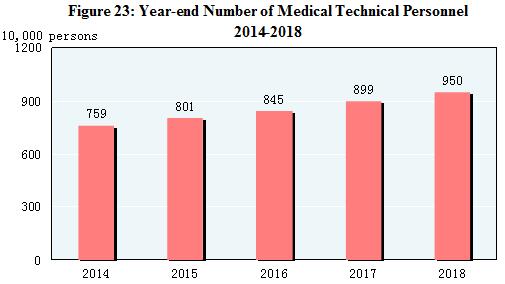
In 2018, Chinese athletes won 118 world championships on 24 sports events and broke 15 world records. Chinese physically-challenged athletes won 50 world championships in 20 international sports competitions.
XII. Resources, Environment and Emergency Management
In 2018, the total supply of state-owned land for construction use[70]was 643 thousand hectares, an increase of 6.6 percent over the previous year. Of this total, the supply for mining storage was 132 thousand hectares, up by 7.2 percent; that for real estate [71]was 144 thousand hectares, up by 24.6 percent; and that for infrastructure facilities was 368 thousand hectares, up by 0.7 percent.
The total stock of water resources in 2018 was 2,796.0 billion cubic meters. With an increase of 1.1 percent over 2017, the total water consumption reached 611.0 billion cubic meters, of which water consumption for living purposes rose by 1.4 percent, for industrial use grew by 0.6 percent, for agricultural use up by 1.1 percent, and for ecological water supplement grew by 3.8 percent. Water consumption for every 10 thousand yuan worth of GDP produced [72]was 73 cubic meters, a decline of 5.1 percent over the previous year. Water consumption for every 10 thousand yuan worth of industrial value added was 45 cubic meters, down by 5.2 percent. Per capita water consumption was 439 cubic meters, up by 0.6 percent.
In 2018, the total area of afforestation reached 7.07 million hectares, of which 3.60 million hectares were afforested by manpower, accounting for 50.9 percent of the total. Forest tending areas reached 8.52 million hectares. By the end of 2018, there were 474 national natural reserves. A total of 54 thousand square kilometers of eroded land was put under treatment programs.
Preliminary estimation indicated that the total energy consumption in 2018 amounted to 4.64 billion tons of standard coal equivalent, up by 3.3 percent over 2017. The consumption of coal increased by 1.0 percent; crude oil, up by 6.5 percent; natural gas, up by 17.7 percent; and electric power, up by 8.5 percent. The consumption of coal accounted for 59.0 percent of the total energy consumption, 1.4 percentage points lower than that of 2017, while clean energy consumption, such as natural gas, hydropower, nuclear power and wind power accounted for 22.1 percent, 1.3 percentage points higher. The comprehensive energy consumption per unit caustic soda of key energy-intensive industrial enterprises went down by 0.5 percent, per unit synthetic ammonia down by 0.7 percent, per ton steel down by 3.3 percent and per unit copper smelting down by 4.7 percent. The standard coal consumption per kilowatt-hour of thermal power generation was decreased by 0.7 percent. The carbon dioxide emission per 10,000 yuan worth of GDP was cut by 4.0 percent.
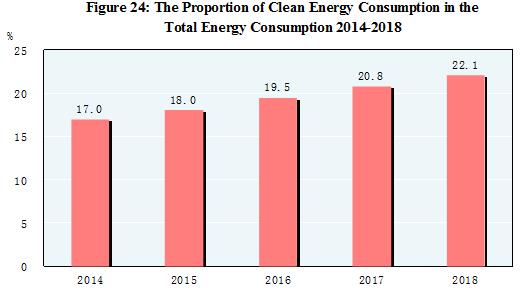
Monitoring of oceanic water quality at 417 offshore monitoring stations indicated that oceanic water met the national quality standard Grade I and II at 74.6 percent of the stations; water quality at 6.7 percent of the stations met Grade III standard; and water of Grade IV or inferior quality was found at 18.7 percent of the stations.
Of the monitored 338 cities at prefecture level and above, 35.8 percent reached the air standard and 64.2 percent failed. The annual average concentration of particulate matter (PM2.5) for cities (based on 262 cities failed to reach the standard of annual average concentration in 2015) that failed to meet the standard stood at 43 micrograms per cubic meter, down by 10.4 percent over the previous year.
Of the 323 cities subject to noise monitoring program, 4.0 percent enjoyed fairly good environment, 63.5 percent had good environment, 30.7 percent had fair environment, 1.2 percent had poor environment and 0.6 percent had very poor environment in downtown areas.
The average temperature in 2018 was 10.09℃, down by 0.30℃ compared with that of the previous year. Typhoons hit China 10 times in 2018.
In 2018, natural disasters hit 20.81 million hectares of crops, of which 2.59 million hectares of crops were demolished. Flood, waterlogging and geological disasters caused a direct economic loss of 106.1 billion yuan. Droughts caused a direct economic loss of 25.5 billion yuan. Disasters from low temperature, frost and snow made a total direct economic loss of 43.4 billion yuan. Oceanic disasters caused a direct economic loss of 4.8 billion yuan. The country recorded 16 earthquakes with magnitude 5 and over, 11 of which caused disasters, causing a direct economic loss of 3.0 billion yuan. The year 2018 witnessed 2,478 forest fires, with 16 thousand hectares of forests damaged.
The death toll due to work accidents amounted to 34,046 people. Work accidents in industrial, mining and commercial enterprises caused 1.547 deaths out of every 100 thousand employees, down by 5.6 percent over 2017. The death toll for one million tons of coal produced in coalmines was 0.093 people, down by 12.3 percent. The road traffic death toll per 10 thousand vehicles was 1.93 people, down by 6.3 percent.
Notes:
1. All figures in this Communiqué are preliminary statistics. Statistics in this Communiqué do not include Hong Kong SAR, Macao SAR and Taiwan Province. Due to the rounding-off reasons, the subentries may not add up to the aggregate totals.
2. Gross domestic product (GDP), value added, per capita GDP and gross national income (GNI) as quoted in this Communiqué are calculated at current prices whereas their growth rates are at constant prices. GDP, shares of three industries’ value added of GDP, the overall labor productivity and other historical data have been revised based on the results of the third national agricultural census.
3. Gross national income, also known as gross national product, refers to the total primary distribution of the income created by all the resident units of a country (or a region) during a certain period of time. It equals to gross domestic product plus the net primary distribution of income from abroad.
4. The national energy consumption per 10,000 yuan worth of GDP is calculated at constant prices of 2015.
5. The overall labor productivity refers to the ratio between the GDP (at 2015 constant prices) and the total number of persons employed.
6. Population who live in places other than their household registration areas refers to those who reside in areas other than their household registration and have been away from there for over 6 months.
7. Floating population refers to the population who live in places other than their household registration excluding those with current residences different from the places of their household registration but still in the same city. Population who live in places other than their household registration but still in the same city refers to those whose current residences are different from the registered towns or streets in the same district or in different districts but still in the same municipality or prefecture-level city.
8. By the end of 2018, the population aged 0 to 14 (under the age of 15) was 235.23 million and that aged 15 to 59 (under the age of 60) was 910.66 million.
9. The number of migrant workers includes those who are employed outside their villages and towns for more than six months in the year and those who do non-agricultural work in their villages and towns for more than six months in the year.
10. The producer prices for farm products refer to the prices of farm products sold directly by producers.
11. The prices for residence include prices for rent, maintenance and management, water, electricity and fuel etc.
12. Capacity utilization rate refers to the ratio of the actual production to the production capacity (in terms of value). Actual production refers to the total industrial output value during the enterprise’s reporting period. Production capacity refers to the production which can be realized and sustained for a long term under the condition of the supply of labor force, materials, fuel and transportation guaranteed and the production equipment in proper operation.
13. The growth rates and rate changes of financial indicators of industrial enterprises above the designated size of 2018 are calculated on a comparable basis due to adjustments of data coverage in the statistical programmes, statistical law enforcement, removal of duplicated data, corporate reforms and divestiture etc.
14. Industrial strategic emerging industries refer to the related industrial sectors of energy-saving and environmental protection, information technology of new generation, biotech, manufacture of high-end equipment, new energy, new materials, and new energy vehicles.
15. High technology manufacturing industry includes manufacture of medicine, manufacture of aerospace vehicle and equipment, manufacture of electronic and communication equipment, manufacture of computers and office equipment, manufacture of medical equipment, manufacture of measuring instrument and equipment and manufacture of optical and photographic equipment.
16. Manufacture of equipment includes manufacture of metal products, general purpose equipment, special purpose equipment, automobiles, railway, ship, aerospace and other transport equipment, electrical machinery and apparatus, computers, communication and other electric equipment and measuring instrument and machinery.
17. Service enterprises above the designated size, refer to legal entities of transport, storage and post, information transmission, software and information technology services, real estate (excluding real estate development and operation), leasing and business services, scientific research and technical services, water conservancy, environment and public facilities management, education, health and social work with annual business revenue of 10 million yuan and above or with 50 employees and above at the end of the year; legal entities of services to households, repair and other services and culture, sports and entertainment with annual business revenue of 5 million and above or with 50 employees and above at the end of the year.
18. Strategic emerging service industries refer to the related service sectors of energy-saving and environmental protection, information technology of new generation, biotech, manufacture of high-end equipment, new energy, new materials, and new energy vehicles.
19. Investment in high technology industries refers to investment in six high technology manufacturing industries, including the manufacture of medicine and manufacture of aerospace vehicle and equipment, and nine high technology service industries, including information service and e-commerce service.
20. Investment in industrial technological transformation refers to the investment in the improvement of the existing equipments, technologies and production services through new technologies, crafts, equipments and materials so as to achieve intensive development.
21. Online retail sales refer to the retail sales of goods and services realized through internet trading platforms (online platforms mainly in trading physical commodities, including self-built websites and third-party platforms). The growth rate of online retail sales in 2018 was calculated on a comparable basis.
22. The number of people lifted out of poverty equals the population in poverty in the current year minus that in the previous year. It is also equivalent to the population out of poverty minus the population returning to poverty in the current year.
23. The incidence of poverty refers to the proportion of population in poverty to targeted population under survey.
24. Impoverished areas cover contiguous poverty-stricken areas and key counties under national poverty alleviation and development program beyond those areas. There were 832 counties altogether. Since 2017, Aksu prefecture in Xinjiang has also been covered in poverty monitoring.
25. Historical data of agriculture, animal husbandry and fishery have been revised based on the results of the third national agricultural census.
26. Output data of some products were reviewed and revised in 2017; therefore the growth rates of output in 2018 were calculated on a comparable basis by applying the revised data.
27. Thermal power refers to electricity generated by coal, oil, gas, residual heat, pressure and gas, waste incineration and biomass.
28. The data include 218.00 million tons of steel which has been reprocessed among enterprises.
29. The growth rate was calculated on a comparable basis as China Electricity Council has changed its statistical coverage in 2018.
30. Some installed power generation capacity was not listed (e.g. geothermal).
31. See note 13.
32. In 2018, the statistical coverage of the volume of freight handled by some ports above the designated size was expanded to all enterprise at the ports; therefore the growth rates of relevant indicators were calculated on a comparable basis.
33. The total passenger traffic includes passenger traffic by railways, highways, waterways and civil aviation for commercial purpose, of which traffic by highways accounted for more than 70 percent. Over recent years, the revolution of people’s travel methods has brought about the fast growth of road trips, online car hailing and carpooling, which has caused a decline of the passenger traffic by highways, as well as the total passenger traffic.
34. The turnover of post services is calculated at constant prices of 2010.
35. The turnover of telecommunication services is calculated at constant prices of 2015.
36. The capacity of mobile phone switchboard refers to the number of maximum concurrent users calculated by mobile phone switchboard according to selected calling models and switchboard processing capacity.
37. Fixed broadband internet users refer to those who subscribed to the telecommunication enterprises and access the Internet through xDSL, FTTx+LAN, FTTH/0 and other broadband access ways as well as general dedicated lines at the end of the reporting period.
38. Fixed fiber-optic broadband internet users refer to those who subscribed to the telecommunication enterprises and access the Internet through FTTH or FTT0 at the end of the reporting period.
39. Mobile broadband users refer to those who have records in the billing system and use 3G or 4G network resources at the end of the reporting period.
40. Software and information technology services industry includes software development, integrated circuit design, information system integration and internet of things technology services, operation maintenance services, information processing and storage support services, IT consulting services, digital content services and other IT services industry.
41. The total retail sales of consumer goods and the subentries in 2017 have been revised as base data according to the results of the third national agricultural census and related regulations. The growth rates of 2018 were calculated on a comparable basis.
42. The base figure of the investment in fixed assets in 2017 was revised according to statistical law enforcement and inspection and the results from the entities inventory checking of the fourth economic census. The growth rates in 2018 were calculated on a comparable basis.
43. The eastern areas include 10 provinces and municipalities: Beijing, Tianjin, Hebei, Shanghai, Jiangsu, Zhejiang, Fujian, Shandong, Guangdong and Hainan; the central areas cover 6 provinces: Shanxi, Anhui, Jiangxi, Henan, Hubei and Hunan; the western areas include 12 provinces, autonomous regions and municipalities: Inner Mongolia, Guangxi, Chongqing, Sichuan, Guizhou, Yunnan, Tibet, Shaanxi, Gansu, Qinghai, Ningxia and Xinjiang; the northeastern areas include 3 provinces: Liaoning, Jilin and Heilongjiang.
44. Private investment in fixed assets refers to investment in the construction or purchase of fixed assets by domestic collective, private and individual-owned enterprises or organizations or their holding enterprises (with absolute holding and relative holding enterprises).
45. Investment in infrastructure includes transportation, postal service, telecommunication, radio, TV and satellite transmission, internet and related services, water conservancy, environment and public facilities management.
46. The investment in real estate includes the investment in real estate development, construction of buildings for own use, property management, intermediary services and other real estate investment.
47. High-speed railways refer to railways with a maximum operating speed of 200 km/h and above and railways with a maximum operating speed less than 200 km/h but only for high speed trains.
48. It refers to the number of dilapidated houses rebuilt belonging to the poverty-stricken households that had their economic status registered at the local governments by the end of December 2018 which was reported by all provinces (autonomous regions and municipalities).
49. The Belt and Road refers to the Silk Road Economic Belt and the 21st Century Maritime Silk Road.
50. The imports and exports of services are calculated according to the sixth edition of Balance of Payments and International Investment Position Manual (BPM6), and the growth rate is calculated on a comparable basis.
51. The increment of social financing refers to the total funds raised by real economy from the financial system over a period of time.
52. The balance of social financing refers to the balance of the funds raised by real economy from the financial system at the end of a certain period of time (a month, a quarter or a year).
53. Funds raised through domestic stock markets are calculated by the money raised on the listing date.
54. National Equities Exchange and Quotations, also called “the New Over-the-Counter Market”, is a national securities exchange established upon approval by the State Council in 2012. Preferred stocks were excluded from Funds raised by listed companies in National Equities Exchange and Quotations.
55. Corporate debenture bonds include debt financing instruments of non-financial businesses, enterprise bonds, corporate bonds and convertible bonds.
56. The premium of primary insurance received by the insurance companies refers to the premium income from primary insurance contracts confirmed by the insurance companies.
57. The median of per capita income refers to the per capita income of household lied in the middle of all surveyed households which are ranked from low to high (or high to low) based on per capita income level.
58. The income quintile refers to the five equal partitions of all surveyed households, who are ranked from low to high based on per capita income level. The top 20 percent with the highest income are classified as high-income group, and the other four levels are upper-middle-income group, middle-income group, lower-middle-income group and low-income group.
59. Rural residents living in extreme poverty refer to the aged, the disabled and the minor under 16 years of age in rural areas who have no ability to work, no sources of income and no statutory obligors to provide for them, bring them up or support them, or whose statutory obligors have no ability to fulfill their obligations.
60. Temporary assistance refers to emergent and transitional assistance the government provides to families or individuals who experience hardships because of emergencies, unexpected harm, major diseases or other unusual factors and are not covered by other forms of social assistance programs or still suffer hardships after receiving other social assistance programs.
61. The beds provided by social welfare institutions include those provided by adoption agencies, aid agencies, community agencies, serviceman recreation habitation and military supply stations etc.
62. The number of PCT patent applications accepted refers to the number of PCT patent application accepted by the State Intellectual Property Office which acts as the receiving office of PCT patent application. PCT is the abbreviation of Patent Cooperation Treaty, which is a treaty for international cooperation in the field of patents.
63. The qualification rate of manufactured products is the ratio of the samples that have passed the sampling quality test, the process of which follows certain methods, procedure and standard, to the total amount of the sampled products. The survey samples cover 29 sectors of the manufacturing industry.
64. Vocational secondary schools include regular specialized secondary schools, adult specialized secondary schools, vocational high schools and skilled workers schools.
65. People received by the public libraries refer to the number of people who visit libraries and use library services in the year, including borrowing and reading books, consultation and attending readers’ programs.
66. Special movies refers to those using different display modes in terms of projection techniques, equipment and program as compared with the ordinary cinemas, such as IMAX movies, 3D movies, 4D movies, multidimensional movies and full dome movies.
67. The average number of books possessed per person refers to the average number of books published in the year that can be possessed per person in China.
68. The total number of medical visits refers to the number of people receiving medical services, including outpatient services, emergency treatment, home visits, appointment-based diagnosis and treatment, health check-up of a specific item, and health consultation and guidance (excluding health lectures).
69. The number of hospital discharges refers to the number of inpatients discharged from hospitals in the reporting period, including those who are discharged from hospitals or transferred to other medical institutions following doctors’ advice, discharged from hospitals without doctors’ permission, dead or other situations. The number of people who are recovered from family sickbeds is excluded.
70. Total supply of state-owned land for construction use refers to the supply of state-owned land for construction use with the land-used right sold, allocated or leased to units or individuals by the municipal or county governments according to annual land supply plan and in line with relevant laws in the reporting period.
71. Land used for real estate refers to the sum of land used for commercial service and for residence.
72. The consumption of water for producing 10 thousand yuan worth of GDP and 10 thousand yuan worth of industrial value added are calculated at 2015 constant prices.
Data Sources:
In this Communiqué, data of urbanization rate of population with household registration, motor vehicles for civilian use and traffic accidents are from the Ministry of Public Security; data of newly increased employed people in urban areas, registered unemployment rate, social security and skilled workers schools are from the Ministry of Human Resources and Social Security; data of foreign exchange reserves and exchange rate are from the State Administration of Foreign Exchange; data of output of aquatic products are from Ministry of Agriculture and Rural Affairs; data of production of timber, area of afforestation, forest tending areas, national natural reserves are from the National Forestry and Grassland Administration; data of areas with effective irrigation system, water resources and soil erosion are from the Ministry of Water Resources; data of installed power generation capacity and newly increased power transformer equipment with a capacity of over 220 kilovolts and above are from the China Electricity Council; data of volume of freight handled by ports, container shipping of ports, highway transportation, waterway transportation, new and rebuilt highways, new throughput capacity of berths for over 10,000-tonnage ships are from the Ministry of Transport; data of railway transportation, new railways put into operation, new double-track railways put into operation and electrified railways put into operation are from China Railway; data of civil aviation and new civil transportation airports are from the Civil Aviation Administration of China; data of pipelines are from China National Petroleum Corporation, China Petrochemical Corporation and China National Offshore Oil Corporation; data of postal service are from State Post Bureau; data of telecommunication, software revenue, and new lines of optical-fiber cables are from the Ministry of Industry and Information Technology; data of housing units rebuilt in rundown areas and dilapidated houses rebuilt belonging to poor rural households that had their economic status registered at local governments are from the Ministry of Housing and Urban-Rural Development; data of imports and exports of goods are from the General Administration of Customs; data of imports and exports of services, foreign direct investment, outbound direct investment, overseas contracted projects and overseas labor contracts are from the Ministry of Commerce; data of finance are from the Ministry of Finance; data of monetary finance and corporate debenture bonds are from the People’s Bank of China; data of funds raised through domestic exchange markets are from China Securities Regulatory Commission; data of the insurance sector are from China Banking and Insurance Regulatory Commission; data of medical insurance, people financed to participate in basic medical insurance program and medical assistance are from the National Healthcare and Security Administration; data of urban and rural minimum living allowances, relief and assistance granted to rural residents living in extreme poverty, temporary assistance and social services are from the Ministry of Civil Affairs; data of entitled people are from the Ministry of Veterans Affairs; data of national key research and experimental development programs, national science and technology major projects, state key laboratories, National Fund for Technology Transfer and Commercialization and technology transfer contracts are from the Ministry of Science and Technology; data of natural science foundation projects are from the National Natural Science Foundation; data of national engineering research centers, national engineering laboratories and enterprise technical centers are from the National Development and Reform Commission; data of patents are from the National Intellectual Property Administration; data of satellite launches are from the State Administration of Science, Technology and Industry for National Defense; data of quality inspection, national standards developed or revised and the qualification rate of manufactured products are from the State Administration for Market Regulation; data of education are from the Ministry of Education; data of art-performing groups, museums, public libraries, cultural centers, books and tourism are from the Ministry of Culture and Tourism; data of television and radio programs are from the National Radio and Television Administration; data of movies are from the China Film Administration; data of newspapers and magazines are from the National Press and Publication Administration; data of files are from the State Archives Administration; data of outbound visitors are from the National Immigration Administration; data of medical care and health are from the National Health Commission; data of sports are from the General Administration of Sport; data of physically-challenged athletes are from the China Disabled Persons’ Federation; data of supply of state-owned land for construction use and direct economic loss caused by oceanic disasters are from the Ministry of Natural Resources; data of the carbon dioxide emission per 10,000 yuan worth of GDP and environment monitoring are from the Ministry of Ecology and Environment; data of average temperature and typhoons are from the China Meteorological Administration; data of areas of crops hit by natural disasters, direct economic loss caused by flood, waterlogging and geological disasters, direct economic loss caused by droughts, direct economic loss caused by low temperature, frost and snow, forest fires, areas of forests damaged and work safety are from the Ministry of Emergency Management; data of the number of earthquakes and direct economic loss caused by earthquakes are from the China Earthquake Administration; all the other data are from the National Bureau of Statistics.
In case of any differences between English translation and the original Chinese text, the Chinese edition shall prevail.
